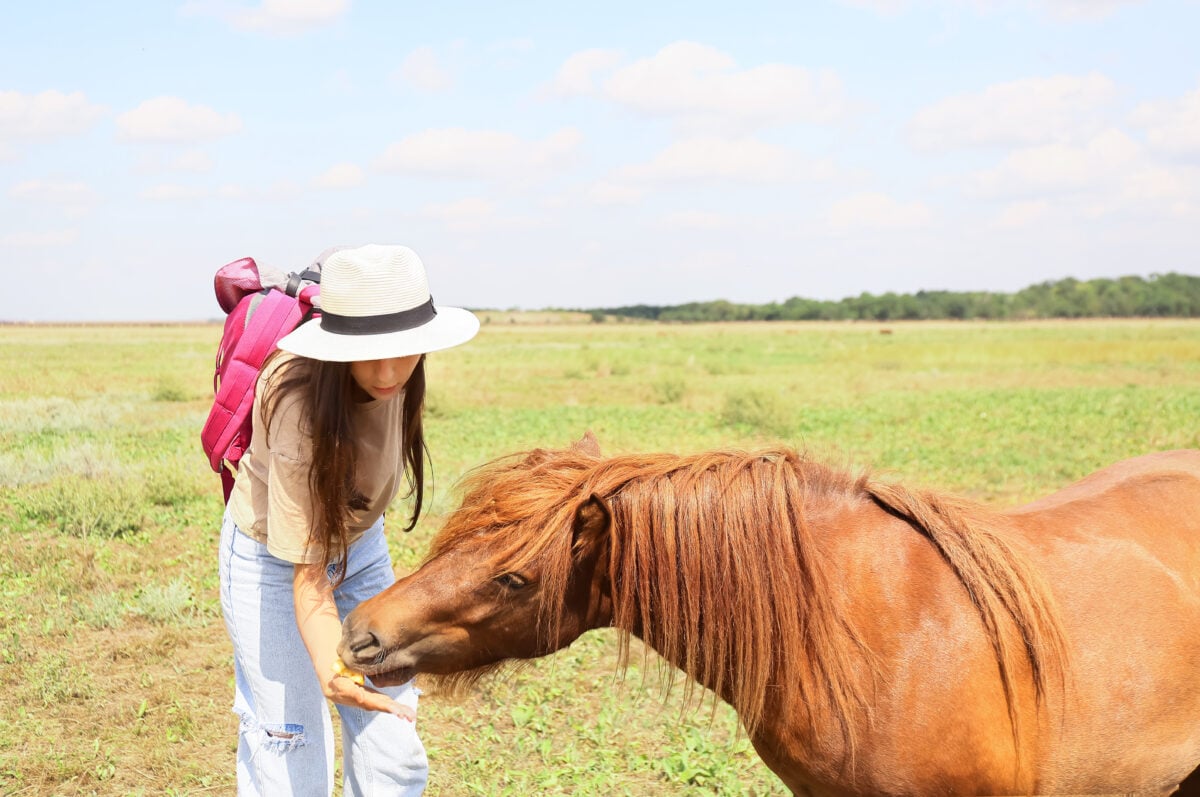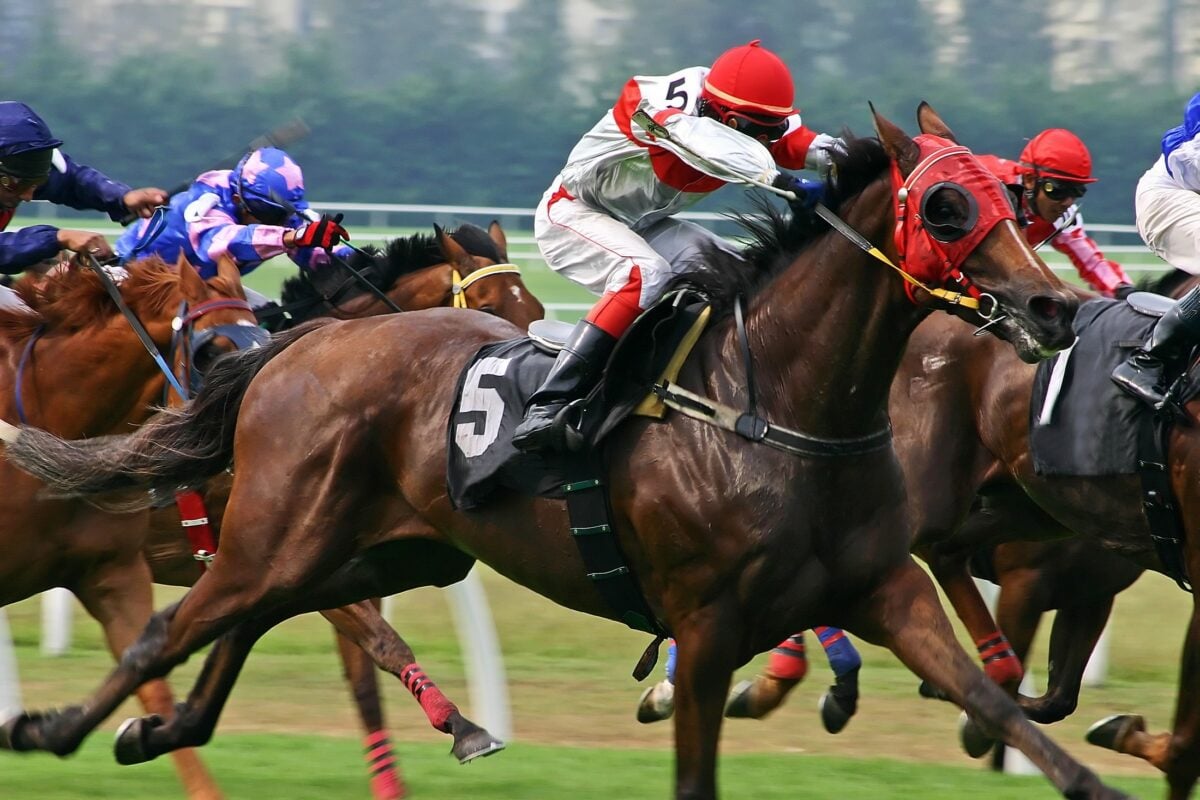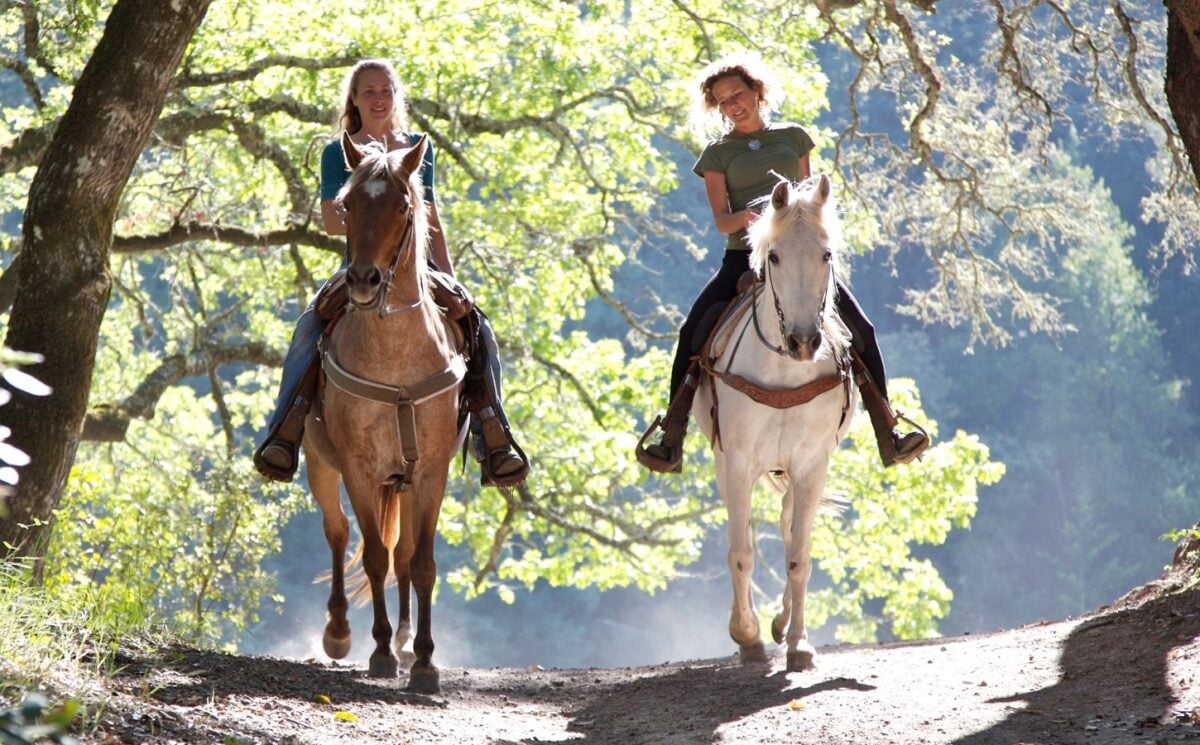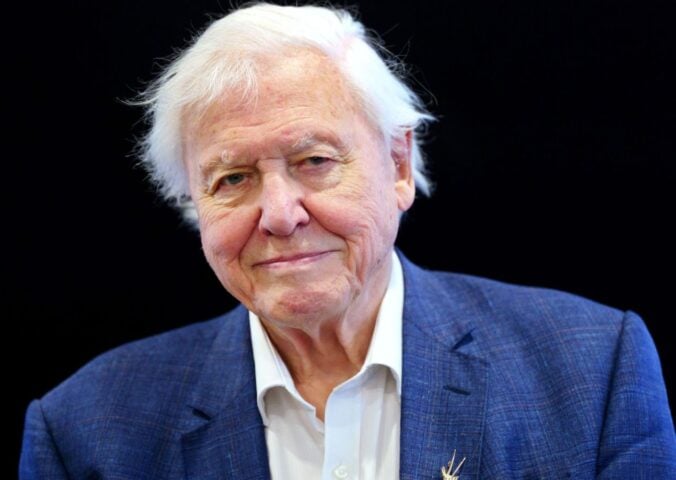Horse riding and racing are hugely popular activities in many countries in the world. While the ethical issues with horse racing are fairly well-documented, it may come as a surprise to some that horse riding is often regarded as cruel. So, is horse riding vegan? And what about horse racing? Let’s delve into it.
In the UK, there have been 2730 racing-related horse deaths in the last 16.5 years. In fact, in 2022 alone, nearly 200 horses were killed as a direct result of racing. And these numbers don’t include the animals killed outside of racing – showjumping, hunting, in on-road collisions, and those who died due to other rider errors, accidents, and negligence. Horses are farmed, homed, bought, sold, and slaughtered like any other animal; as a product.
Even when everything goes according to a rider’s plan, horse riding inherently involves the exploitation of animals. Horses do not “need” to be ridden, and horseback riding of any kind exists solely to benefit the humans involved – whether that is for entertainment, profit, or fun.
With that in mind, can horse riding ever really be considered compatible with veganism?
Is horse riding vegan?

By definition, a vegan is someone who avoids all foods, products, and activities that involve animal exploitation, to whatever extent this is possible and practical. Veganism often looks different to different people, but folks generally agree that being vegan extends beyond a strict plant-based diet to include interrelated ethical issues such as animal testing, environmental destruction, and the use of animals for entertainment.
By the above definition, horse riding cannot be considered vegan. But many people still type this question into search engines every year, and debate it online. There are self-described vegan jockeys, and you can even get plant-based horse accessories like saddles and reins. Horse riders remain adamant that they love their horses, and that riding is a core part of that.
Part of the problem, arguably, is that horses are frequently painted as willing participants in thrilling but otherwise harmless sports and activities that occasionally result in a tragic death. But the reality of horse riding – and racing, in particular – is quite different.
Let’s dive into the history of humanity’s relationship with horses and why modern equestrian pursuits like horse riding – even for leisure – are inherently exploitative.
How long have humans worked with horses?
Humans began riding horses at least 5,000 years ago. It’s likely that the domestication of horses began as a means of survival, as with the initial domestication of dogs, and that the animals were used for hunting and covering longer distances more quickly than on foot.
The Mongolian Wild Horse, or Takhi, is now arguably the only truly wild horse remaining in the world, with the majority of so-called “wild” horses actually ferals – meaning that they are formerly domesticated or the descendants of domesticated animals left to run free. (For example, semi-wild herds of horses can be found in the UK’s New Forest and on Exmoor.)
In much the same way that the domestication of dogs forever changed canine history – or how all modern “cattle” but the Indian bison are also either domesticated or feral – the human domestication and breeding of horses has altered the species irrevocably.
The first steps towards horse domestication led to their widespread use throughout Eurasia as transportation, in warfare, and for agricultural tasks such as plowing. As recently as the 1980s working horses could still be found in the UK, but today they are almost entirely used for recreation, entertainment, and in competitive sports like racing.
Horse welfare, injuries, and deaths

The act of horse riding
The majority of the cruelty experienced by horses is perpetuated by the equestrian industry, including breeding, training, and racing for profit. But some argue that “breaking” a horse at all (getting them used to rider and accessories) is inherently cruel.
In fact, many of the behaviors previously viewed as undesirable by riders – such as tail swishing and flattened ears – may actually be an outward sign of musculoskeletal pain or discomfort from carrying a person. (Younger horses, in particular, are ridden as young as three, which can cause long-term and chronic damage to their still-growing bodies.)
Overall, horses have not evolved to carry humans; they have evolved to roam and live their own lives, and horseback riding is something that has been put upon them. Initially out of necessity for human survival, and now primarily for entertainment and financial gain.
For the most part, modern riders are entirely dependent on the “tack,” or accessories, required to be able to ride a horse at all. But the use of a “bit” – the piece of equipment that interacts with a horse’s mouth and gives the rider control of the head – can cause bruises, lesions, and sores as well as chronic breathing and swallowing issues in horses.
Whips are also commonplace, albeit typically a modernized, foam-padded version. But at best, whipping a horse with a less aggressive instrument still causes discomfort, and at worst it causes wounds. Spurs have also changed a great deal, but horses still receive cuts and marks from their use, particularly from overzealous riders during competitive riding.
Horses are extremely sensitive animals, and in contrast to the industry’s stance, science backs the argument that they feel very real pain from whipping, spurs, and use of a bit. After all, these are systems designed to exert control by inflicting discomfort.
Living conditions
Horses are naturally social animals, and a typical, healthy horse would very rarely choose to live alone. Like other cows and other herbivorous hoofed mammals, horses can form strong, long-lasting friendships. They also like to run and play and prefer to move around and graze all day long. (Hoof trimming is required specifically due to this lack of movement.)
In the racing industry, in particular, horses can spend up to 22 hours per day confined to a stall. This causes distress which manifests in abnormal behaviors comparable to those seen in factory-farmed cattle and other animals. For example, walking in circles, weaving, and “wind-sucking” – biting an object and sucking in air – the latter of which can cause colic.
More generally, many parts of the equestrian industry rely on the transportation of horses, sometimes over extremely long distances. Even horses who are accustomed to riding in a trailer experience some degree of stress and this has been directly linked to health issues such as injury, respiratory disease, and gastrointestinal disease.
In addition to the ethical issues surrounding what are fairly standard living conditions for horses, there are outlying issues of abuse and negligence. Hard data on this subject can be elusive, but World Horse Welfare estimates that upwards of 6,000 UK horses are at risk of neglect and suffering nationwide.
Health and horse breeding
In addition to the health issues that develop from living conditions and neglect, world-class race and showjumping horses may experience vulnerabilities and illness from inbreeding. Thoroughbred horses have been bred for the extremely specific purpose of competing in sports, which may result in poorer overall health and otherwise avoidable injuries.
According to a report by Animal Aid, three times as many horses are being produced than 40 years ago, with a decreasing proportion (around 35 percent) of that population sufficiently healthy to actually participate in racing. This pursuit of an “ideal” Thoroughbred has resulted in the “over-production of a swift but physically weak” horse.
Animal Aid also notes that up to 75 percent of all race horses suffer from bleeding lungs, while 93 percent of horses in training experience gastric ulcers. The latter condition gets progressively worse during training and improves when (and if) a horse reaches retirement.
Beyond individual animal health, horse breeding is its own industry with its own ethical issues and considerations. Breeding stallions are kept isolated for up to 20 years and are typically viewed as offspring-producing machines, while breeding mares are subjected to the same endless cycle of pregnancy that all intensively farmed female animals experience.
Deaths
Countless horses are injured each year taking part in equestrian activities from showjumping to hunting, with anything the industry deems a “catastrophic” injury leading to euthanasia. But racing is overwhelmingly the leading cause of injury, death, and destruction for UK horses.
While the industry says it is doing all it can to reduce the number of fatalities that happen every year, the number of horse racing deaths is increasing – approximately 50 racehorses died in just the first four months of 2023 – while an unknown additional number are killed in training or behind the scenes because they failed to perform adequately.
Jump racing is notably much more hazardous for horses than races on flat ground, and a study carried out by the University of Melbourne in 2006 reported the risk of injury and death for a horse competing in a jump race as 18.9 times higher than a horse competing in a flat race. But overall, horse deaths are simply commonplace throughout all types of racing.
The majority of the animals killed while racing experience a broken back, neck, leg, or pelvis, a heart attack, or burst blood vessels from being pushed to maximum exertion. It’s been argued that one factor in increasing deaths is unsafe racing conditions, but another is the dwindling health and stamina of the Thoroughbred horses which monopolize racing.
Outside of professional sports, riding horses on UK roads can be a high-risk affair too, and a total of 68 horses were killed and 125 riders were injured in 2022 while riding on paved roads.
Supporting horse protection
Just 3.5 percent of Brits ride horses, and public perception is changing rapidly.
A study carried out by YouGov on behalf of World Horse Welfare revealed that at least 60 percent of people believed there should be more safety and welfare measures in place for all equine sports, with 40 percent stating that their support depended on improvements.
Furthermore, a significant 20 percent of those surveyed believed that horses should no longer be involved in sport under any circumstances. Last year also saw unprecedented media coverage of protests at the Grand National, which attempted to prevent further deaths and came just moments before the third horse of the event was killed on the track.
If you love horses and want to be around them, visiting or volunteering at an animal sanctuary is one of the best things you can do. There are a variety of sanctuaries that home large farm and working animals, including horses, such as the vegan-run Horse and Farm Animal Sanctuary in Wales, Pear Tree Farm in Somerset, and Hillside Animal Sanctuary in Norfolk.
You can check out Animal Aid’s Sanctuary Not Cruelty campaign here.






